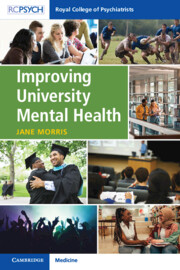Book contents
- Improving University Mental Health
- Improving University Mental Health
- Copyright page
- Contents
- Foreword
- Acknowledgements and Thanks to Contributors
- Chapter 1 Introducing This Handbook
- Chapter 2 Building a New Sense of Belonging
- Chapter 3 The Transition to University for New Students with Pre-Existing Mental Conditions
- Chapter 4 The Roles of Parents and Carers
- Chapter 5 Healthy Bodies, Body Image Concerns, Eating Disorders
- Chapter 6 Alcohol
- Chapter 7 Substance Misuse
- Chapter 8 Social (and Anti-social) Media
- Chapter 9 Finance and Mental Health
- Chapter 10 Neurodiversity
- Chapter 11 Ethnically Diverse University Communities
- Chapter 12 Sexual Behaviour and Gender Identity in Universities
- Chapter 13 The Mental Health of Teaching and Academic Staff
- Chapter 14 An Overview of Mental Disorders in Students and Staff
- Chapter 15 ‘Psychotic’ Disorders
- Chapter 16 Mood Disorders
- Chapter 17 Suicide at University
- Chapter 18 Mental Health Services on Campus and in the NHS
- Chapter 19 Students of the Professions and ‘Fitness to Practise’ Issues
- Chapter 20 Summing It All Up
- Index
- References
Chapter 6 - Alcohol
Published online by Cambridge University Press: 08 February 2024
- Improving University Mental Health
- Improving University Mental Health
- Copyright page
- Contents
- Foreword
- Acknowledgements and Thanks to Contributors
- Chapter 1 Introducing This Handbook
- Chapter 2 Building a New Sense of Belonging
- Chapter 3 The Transition to University for New Students with Pre-Existing Mental Conditions
- Chapter 4 The Roles of Parents and Carers
- Chapter 5 Healthy Bodies, Body Image Concerns, Eating Disorders
- Chapter 6 Alcohol
- Chapter 7 Substance Misuse
- Chapter 8 Social (and Anti-social) Media
- Chapter 9 Finance and Mental Health
- Chapter 10 Neurodiversity
- Chapter 11 Ethnically Diverse University Communities
- Chapter 12 Sexual Behaviour and Gender Identity in Universities
- Chapter 13 The Mental Health of Teaching and Academic Staff
- Chapter 14 An Overview of Mental Disorders in Students and Staff
- Chapter 15 ‘Psychotic’ Disorders
- Chapter 16 Mood Disorders
- Chapter 17 Suicide at University
- Chapter 18 Mental Health Services on Campus and in the NHS
- Chapter 19 Students of the Professions and ‘Fitness to Practise’ Issues
- Chapter 20 Summing It All Up
- Index
- References
Summary
There are high levels of alcohol in the UK population, with a particularly damaging pattern of ‘binge drinking’. Extreme alcohol use remains embedded in university culture. Since COVID and lockdown, male students, postgraduates and academic staff are likely to have increased their alcohol consumption. Starting university marks a rise in alcohol intake, to reduce social anxiety and ‘belong’ to the prevailing culture. High risk sexual behaviours rise significantly when alcohol is taken. Death by suicide, and deliberate self-harming, are associated with alcohol use. This is an important modifiable risk factor in addressing sexual violence and suicide. Mental disorders are strongly associated in complex interactions with alcohol use. Heavy alcohol use may be associated with other substance misuse and addictive behaviours. Abstaining from alcohol may result in striking improvements in mental health and academic performance. The rights and wellbeing of non-drinkers need to be acknowledged too. Information campaigns and paying lip service to disapproval do not work. The student age group tends to be less risk-averse than older groups. It falls to university authorities in partnership with local communities to control high risk alcohol intake.
Keywords
- Type
- Chapter
- Information
- Improving University Mental Health , pp. 72 - 89Publisher: Cambridge University PressPrint publication year: 2024



